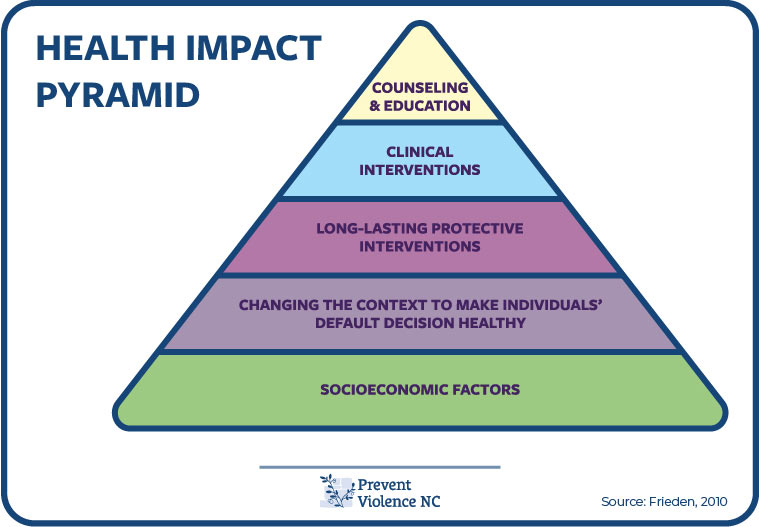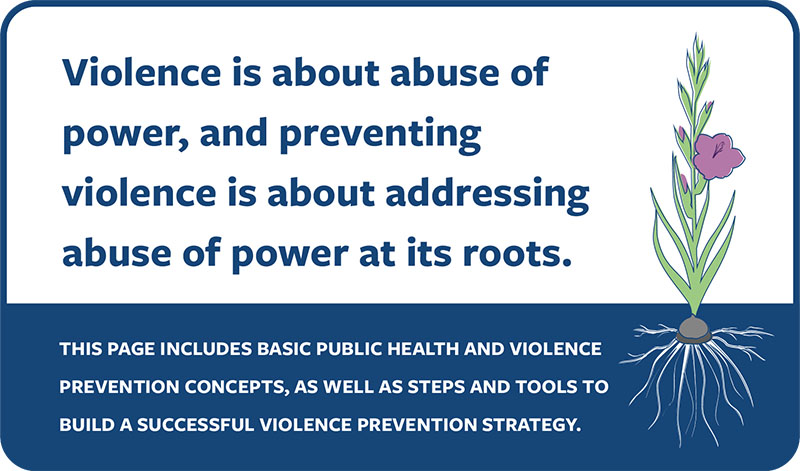
 Violent behavior is complex
Violent behavior is complex
Effective violence prevention requires understanding the equally complex answers to these two simple questions:
1. Why does violence occur?
2. How do we prevent it?
Violence is about abuse of power and preventing violence is about addressing abuse of power at its roots. We’ve created an interactive theory of change to visually show the ways violence is rooted in systems of advantage and oppression. Systems of advantage and oppression create power imbalances in our society and are like contaminates in the groundwater that impact every aspect of life.
What is Primary Violence Prevention?
Violence Prevention can refer to preventing people from becoming victims of violence. It can refer to preventing people from becoming perpetrators of violence. Both of these forms of prevention can take place before the first incident ever occurs (primary prevention). Or they can take place later, to prevent violence from occurring again and to mitigate the immediate and long-term effects of violence (secondary and tertiary prevention).
Primary prevention is prevention of first-time perpetration. The goal of Prevent Violence NC is to support people working to prevent first-time perpetration of violence with resources and information to make their efforts more successful. The selected strategies are centered on ensuring people do not engage in violent behaviors. We do this by fostering individual, family, community, and societal supports and positive norms. We call these the Key Strengths.
Some definitions of primary prevention include strategies to prevent victimization. Strategies to prevent first-time victimization include things like recognizing and avoiding risk. Though these strategies may be considered part of a broader approach to violence prevention, PVNC specifically does not include these approaches for several important reasons:
- They place responsibility for preventing violence on the potential victims of violence. This also can lead to victim blaming.
- They do little to prevent someone who has not been reached by the prevention strategy from being victimized.
- They tend to emphasize actions individuals can or should take to avoid violence, rather than addressing its root causes.
- Victimization focused strategies only work to prevent people from becoming victims of violence. Perpetration focused prevention is more effective and more efficient because it addresses root causes and has the ability to stop both perpetration and victimization.
The result of this approach is less sustainable and more limited in reach. It fails to impact the systems, attitudes, and norms that allow violence to persist.
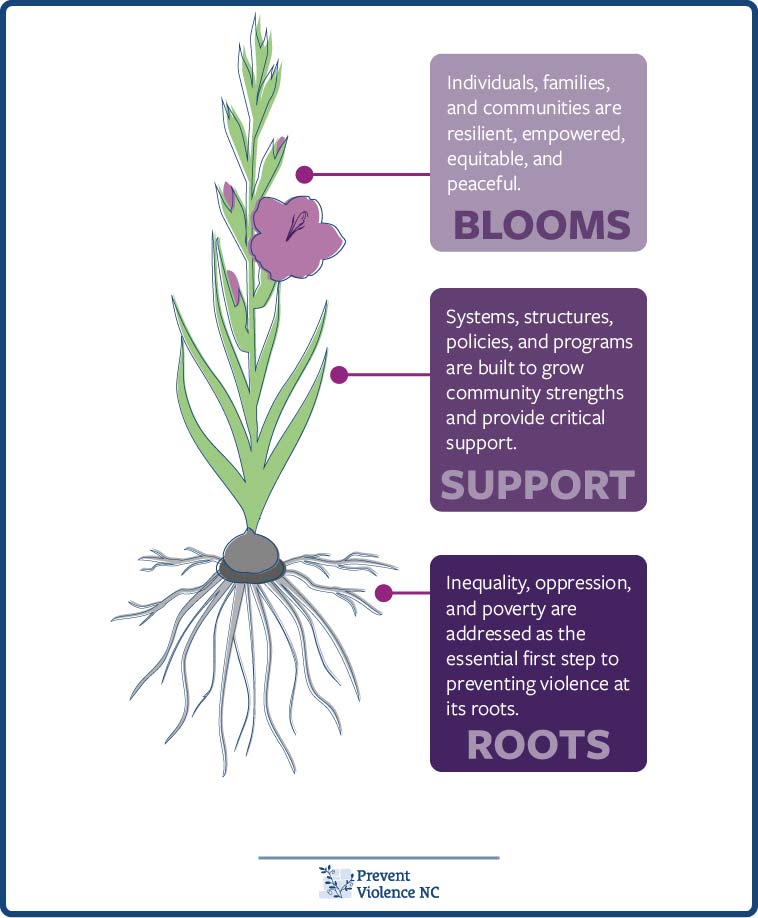
Social Ecological Model
The public health approach to prevention uses models to help us understand the different factors that affect the health and wellbeing of individuals and populations. The Social Ecological Model, also called the social ecology, helps us to understand the various levels of influence on people’s lives. The term social ecology comes from public health, and describes the organic, interactive organization of people’s relationships within and across these different sized groups. On this version of the model, there are examples of the kinds of influences that exist at the individual, relationship, community, and societal levels. Often this model is illustrated using concentric circles or ovals.
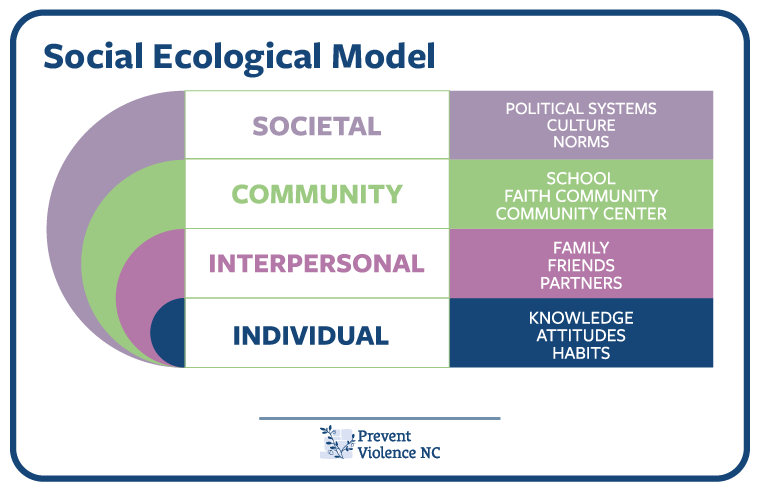
When we are planning for violence prevention, we can use the social ecological as a tool to map and understand where various risk and protective factors occur in the social ecology and their level of influence on a populations’ violence outcomes. This also then helps us to understand what points of intervention might be most effective. When we talk about an ”upstream approach“ or “outer layers” in public health, we‘re talking about the community and societal levels. These are the levels we can work on to effect change that is both lasting and far reaching.
Risk and Protective Factors
One way that we can work to address violence where it begins is to use strategies that decrease risk factors and increase protective factors. Risk factors are the things that make it more likely that people with experience or perpetrate violence. Protective factors are the things that make violence less likely to happen or help to buffer against the impact of risk factors. Protective factors can also increase resilience.
Risk Factors:
- INCREASE the likelihood a person will use violence. “They are contributing factors and may or may not be direct causes.” (CDC)
- ARE NOT determinative. “Not everyone who is identified as at risk becomes a perpetrator of violence.” (CDC)
Protective Factors:
- BUFFER against risk. They are conditions, characteristics, and influence that may decrease the likelihood of perpetrating or being the victim of violence.
- ENCOURAGE a positive, health-promoting focus. They are at the core of asset-based or strengths-based prevention strategies.
Characteristics of Risk and Protective Factors
Because risk and protective factors help to explain and predict the likelihood of violence, they can be incredibly useful tools for developing violence prevention strategies. When developing a prevention strategy to address the risk or protective factors relevant to your community, there are some important things to keep in mind:
Shared Risk and Protective
One of the major motivators behind the Prevent Violence NC website was to pull together information about shared risk and protective factors in an actionable way for preventionists. Since the initial development, we’ve integrated our understand of SRPF into a broader analysis of systemic and institutional power structures. This gives us a more nuanced understanding of what shapes risk and protective factors.
Focusing on these shared risk and protective factors is likely to:
- Have an IMPACT on many outcomes
- Increase opportunities for NEW PARTNERSHIPS and audiences
- Increase the EFFECTIVENESS of our collaboration with partners
- Allow advocates to LEVERAGE scarce prevention resources
- ACKNOWLEDGE the complex reality in which violence takes place
- EXPAND the notion of what constitutes violence prevention to include a larger selection of proven approaches to promote wellbeing
Researchers at the Centers for Disease Control and Prevention and the Prevention Institute outlined the advantages and importance of using shared risk and protective factors in violence prevention in their brief, Connecting the Dots: An Overview of the Links Between Multiple Forms of Violence. Focusing on shared risk and protective factors can be a highly effective and engaging way to structure a comprehensive violence prevention strategy because there:
- are countless influences on violence
- is a tendency for multiple forms of violence to co-occur within individuals, families, and communities
- are limited resources available to address violence
Prevent Violence NC organizes a large set of risk and protective factors into a set of six Key Strengths for violence prevention. When nurtured and supported in communities, families, and individuals, each of these Key Strengths can help to prevent North Carolina’s five prioritized violence outcomes:
- child maltreatment
- intimate partner violence
- sexual violence
- suicide
- youth violence
Read about how to use risk and protective factors and our Key Strengths to guide prevention efforts.
Developing a Prevention Strategy

Violence was once thought to be inevitable. It is now being increasingly recognized as a preventable, public health problem. The public health model for violence prevention recommends a four-step process to systematically approach violence. Developing a prevention strategy can be relatively straightforward or rather complex. Many excellent guides and resources, such as the Community Tool Box, are available online and in print. Below, you'll find basic guidance related to using risk and protective factors to begin developing or selecting a prevention strategy. Many of the examples and resources are specifically for prevention in the state of North Carolina. For more in-depth support on prevention program planning consider contacting North Carolina Coalition Against Domestic Violence or sending us a question through the contact form.
FIRST, LEARN ABOUT YOUR COMMUNITY TO MAKE SURE YOUR PREVENTION STRATEGY IS RELEVANT FOR YOUR COMMUNITY. Prevention cannot be a one-size-fits-all approach because different communities have different strengths and challenges and different cultures. In order to be successful, it is important that prevention efforts are relevant to your community and involve members of the community in a meaningful way. Before developing or selecting a prevention strategy, it is essential to assess which risk and protective factors are present, among which groups and individuals, and to understand your community’s readiness to address those risk and protective factors. There are several ways to do this.
Collect your own data: There are many ways to collect data in your community. It is important that when you are collecting data that you do so in a way that is accessible for the community, especially those who are most marginalized, and allows the community to define their own experience in a way that works for them. Below are some of the options for how to collect data in you community.
Using existing, secondary data sources: Secondary data sources refer to data and information that was collected by someone else and can provide information about the issue you are trying to address. Below are some examples of some larger datasets available in NC. You can also seek secondary data that is specific to your community through various community partners such as (but not limited to): local health departments, social services agencies, local government, local agencies that do research or evaluation, local school systems etc.
Learn from what others are doing: Understanding what other local organizations are prioritizing or working on can provide clues about which risk and protective factors may be relevant to the community – not to mention uncovering potential partners for your prevention work.- Attend conferences and workshops.
- Join multidisciplinary task forces.
- Join mailing lists.
- Follow social media.
As you can see, there are several ways of gathering and learning information about your community. Each of these methods come with their own benefits and challenges. It is important to know what questions to ask that will help you understand what type of data you need to effectively prevent violence in your community. Some questions to consider are:
- What do you need to know about your community?
- Who do you need to learn from?
- How hard is it to know that information?
- How intensive will it be to get that information?
- Does somebody already have that information?
Secondary data is helpful for giving you a bird's eye view on an issue and the general frequency of different things happening within a community. Gathering primary data by talking to a community will help you understand the priorities and goals of the community, their perceptions and on why certain things are happening within the community, and their ideas regarding the best approach for making change. Through this process you may learn about violence prevention efforts that are already underway, that may or may not be called violence prevention. Learning about other efforts occurring in your community allows you to coordinate efforts, support existing efforts with various violence prevention resources, and increase your overall collective impact within your community.
Prioritizing Risk & Protective Factors
PRIORITIZE. FOCUS ON RISK AND PROTECTIVE FACTORS THAT ARE IMPORTANT, CHANGEABLE, FEASIBLE, AND HAVE BROAD IMPACT: When you have determined the set of risk and protective factors relevant to your community, you will likely need to narrow your list. In order to prioritize the factors your prevention work will address, involve community partners in determining:
One tool that can help you and your community prioritize which risk and protect factors you want to address is the prioritization matrix. When using it, place the risk and protective factors on the chart around how important and changeable they might be FOR YOUR COMMUNITY. This can be used as an interactive tool with your community to visually see how to prioritize your time and resources.
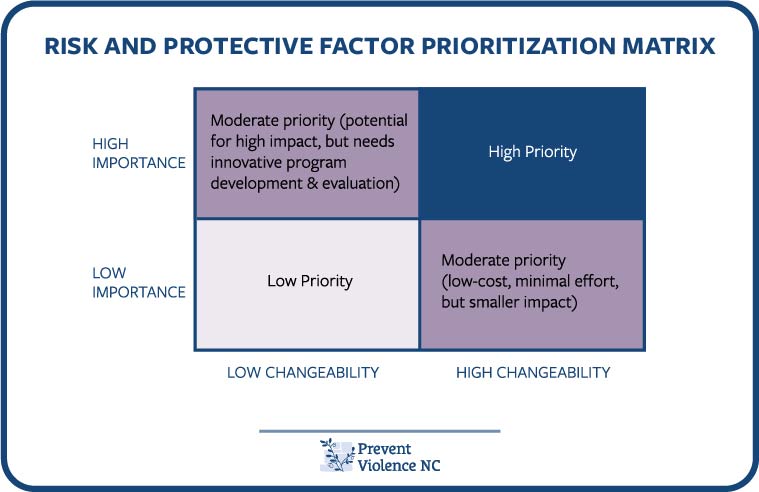
It’s really tempting to only ever go after the HIGH importance HIGH Changeability and HIGH Changeability LOW importance because our funding requires quick turn arounds and quick success. It’s important to also do HIGH Importance and LOW changeability because these are very sustainable once we’ve made the change. That’s why it’s hard to change in the first place. When we are planning our prevention efforts it’s really important for us to be thinking past the 1-5 year time frame to the long term to be putting in place the building blocks that will allow us to be able to make the bigger, more sustainable, deeper changes…
 Prevention is a LONG TERM process
Prevention is a LONG TERM process
For a blank printable worksheet of the prioritization matrix, click here.
Health Impact Pyramid
Once you have prioritized which risk and protective factors to address in your community, it’s time to select, plan, and implement the strategies you will use to address them. The PVNC strategies section can give you some ideas on approaches and programs. Another tool that can help you select or develop an effective and impactful strategy is the Health impact pyramid.
9 Principles of Effective Prevention Programs
When considering what programs or strategies you want to use to address your prioritized risk and protective factors, another set of guidance to consider the 9 Principles of Effective Prevention Programs.
Special thanks to Dr. Beth Moracco, PhD at the University of North Carolina Gillings School of Global Public Health

